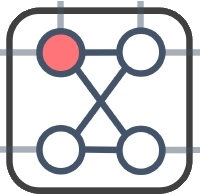アニーリングを用いたアンサンブル学習(QBoost)#
QBoostは量子アニーリングを用いたアンサンブル学習の一つです。 アンサンブル学習は弱い予測器を多数用意し、その予測器の各予測結果を組み合わせることで、最終的に精度の良い予測結果を得る手法です。
概要と原理#
このQBoostは、入力信号がどのような性質を持っているのかを精度良く識別することを目標としたアルゴリズムです。ここでは2つの値のどちらを入力信号に割り当てるべきかという問題を考えましょう。例として、が画像データを表しており、その画像に写っているものが犬か猫かを識別するといったタスクを想像すると良いでしょう。アンサンブル学習では、複数の予測器を利用することで、より良い予測精度を達成すること(ブースティング)を目指します。ここでは、あまり性能の良くない予測器(弱い予測器)をたくさん用意します。性能が良くないという意味は、入力に対して正しい出力をしないことが多いことを意味します。これらの予測器の出力をとします。いくつかの弱い予測器の出力の和を取ることで、より良い予測ができるというのが基本的な考え方です。これを数式で表すと
となります。ここでで、番目の予測器を使うか使わないかを表します。どの予測器を用いると、できるだけ少ない数の弱い予測器でより良い性能が得られるかを明らかにしましょう。
このために、教師あり学習を用いて最適なの組を求めることにします。教師データをを多数用意します()。それらをできるだけ忠実に再現するようにを調整します。
この方針をより具体的に表すと、次のハミルトニアンをについて最小化することを目指せば良いとわかります。
このハミルトニアンの最小化を通して、教師データとの差ができるだけ小さくなるようにします。式(1)の右辺をそのまま使うと、符号関数があるためにの2次形式にならず、イジング模型に帰着することができません。そのため、符号関数の引数の倍と教師データとの差の2乗を最小化する問題にしています。の係数は、の最大値がであるためにとの差が大きくなりすぎないのように調整するためのものです。がかかった項は、あまり多くのを1にせず、比較的少数の弱い予測器で効率良く構成するための項(正則化項)を表します。
JijModelingによるモデル構築#
変数の定義#
式(2)で用いられている変数を、以下のようにして定義しましょう。
import jijmodeling as jm
# define variables
c = jm.Placeholder("c", ndim=2)
y = jm.Placeholder("y", ndim=1)
N = c.len_at(0, latex="N")
D = c.len_at(1, latex="D")
w = jm.BinaryVar("w", shape=(N, ))
lamb = jm.Placeholder("lamb", latex="\lambda")
i = jm.Element("i", belong_to=(0, N))
d = jm.Element("d", belong_to=(0, D))
c = jm.Placeholder('c', ndim=2)で式(2)のを定義しています。
そのリストの要素数から、弱い予測器の数と教師データ数をそれぞれN, Dとして定義しています。
それらを用いて、最適化に用いるバイナリ変数wと教師データのバイナリ値yを定義しています。
式(2)のをlambとして定義し、最後に式(2)で用いられている添字をi, dのように表しています。
目的関数の実装#
式(2)を実装しましょう。
# set problem
problem = jm.Problem("QBoost")
# set objective function 1: minimize the sum of differences
obj1 = jm.sum(d, (jm.sum(i, w[i]*c[i, d])/N-y[d])**2)
# set objective function 2: minimize regularization term
obj2 = lamb * w[:].sum()
problem += obj1 + obj2
w[:].sum()とすることで、を簡潔に実装することができます。
ここまでの実装が正しくされているかを確認しましょう。
problem
インスタンスの作成#
実際に実行するタスクなどを設定しましょう。今回は弱い予測器をscikit-learnのdecision stump(決定株: 一層の決定木)を用います。 また用いるデータはscikit-learnの癌識別データセットを使用します。
import numpy as np
from sklearn import datasets
from sklearn.tree import DecisionTreeClassifier as DTC
def prediction_from_train(N, X_train, y_train, X_test):
# set the number of ensembles to be taken out for one sample in bootstrap sampling
sample_train = 40
# set model
models = [DTC(splitter="random", max_depth=1) for i in range(N)]
for model in models:
# extract randomly
train_idx = np.random.choice(np.arange(X_train.shape[0]), sample_train)
# make decision tree with variables
model.fit(X=X_train[train_idx], y=y_train[train_idx])
y_pred_list_train = []
for model in models:
# execute prediction with model
y_pred_list_train.append(model.predict(X_train))
y_pred_list_train = np.asanyarray(y_pred_list_train)
y_pred_list_test = []
for model in models:
# execute with test data
y_pred_list_test.append(model.predict(X_test))
y_pred_list_test = np.array(y_pred_list_test)
return y_pred_list_train, y_pred_list_test
# load data
cancer_data = datasets.load_breast_cancer()
# set the number of train data
num_train = 200
# add noise to feature
noisy_data = np.concatenate((cancer_data.data, np.random.rand(cancer_data.data.shape[0], 30)), axis=1)
# convert (0, 1) label to (-1, 1)
labels = (cancer_data.target-0.5) * 2
# divide dataset to train and test
X_train = noisy_data[:num_train, :]
X_test = noisy_data[num_train:, :]
y_train = labels[:num_train]
y_test = labels[num_train:]
# set the number of classifer
inst_N = 20
# predict from train data using dicision tree classifier
y_pred_list_tarin, y_pred_list_test = prediction_from_train(inst_N, X_train, y_train, X_test)
# set lambda (coefficient of 2nd term)
inst_lamb = 10.0
instance_data = {'y': y_train, 'c': y_pred_list_tarin, 'lamb': inst_lamb, 'y_train': y_train, 'y_test': y_test, 'y_pred_list_test': y_pred_list_test}
---------------------------------------------------------------------------
ModuleNotFoundError Traceback (most recent call last)
Cell In[4], line 2
1 import numpy as np
----> 2 from sklearn import datasets
3 from sklearn.tree import DecisionTreeClassifier as DTC
5 def prediction_from_train(N, X_train, y_train, X_test):
6 # set the number of ensembles to be taken out for one sample in bootstrap sampling
ModuleNotFoundError: No module named 'sklearn'
デモンストレーションのために、ノイズとなる特徴量を加えたものを実際のデータとして用います。
prediction_from_train関数を用いて弱い予測器の作成と、それらの予測器からの出力を作成しています。
ここでは弱い予測器の数を20、教師データ数は200です。最後に式(2)のの値を3.0としています。
JijModeling transpilerによるPyQUBOへの変換#
ここまで行われてきた実装は、全てJijModelingによるものでした。 これをPyQUBOに変換することで、OpenJijはもちろん、他のソルバーを用いた組合せ最適化計算を行うことが可能になります。
import jijmodeling_transpiler as jmt
# compile
compiled_model = jmt.core.compile_model(problem, instance_data, {})
# get qubo model
pubo_builder = jmt.core.pubo.transpile_to_pubo(compiled_model=compiled_model, relax_method=jmt.core.pubo.RelaxationMethod.AugmentedLagrangian)
qubo, const = pubo_builder.get_qubo_dict(multipliers={})
import openjij as oj
# set sampler
sampler = oj.SASampler()
# solve problem
result = sampler.sample_qubo(qubo, num_reads=100)
# decode a result to JijModeling sampleset
sampleset = jmt.core.pubo.decode_from_openjij(result, pubo_builder, compiled_model)
objectives = np.array(sampleset.evaluation.objective)
lowest_index = np.argmin(objectives)
w_indices = sampleset.record.solution["w"][lowest_index][0][0]
from sklearn.metrics import accuracy_score
y_pred_list_train = instance_data['c']
y_train = instance_data['y_train']
y_test = instance_data['y_test']
y_pred_list_test = instance_data['y_pred_list_test']
accs_train_oj = []
accs_test_oj = []
for solution in sampleset.record.solution["w"]:
idx_clf_oj = solution[0][0]
y_pred_train_oj = np.sign(np.sum(y_pred_list_train[idx_clf_oj, :], axis=0))
y_pred_test_oj = np.sign(np.sum(y_pred_list_test[idx_clf_oj, :], axis=0))
acc_train_oj = accuracy_score(y_true=y_train, y_pred=y_pred_train_oj)
acc_test_oj = accuracy_score(y_true=y_test, y_pred=y_pred_test_oj)
accs_train_oj.append(acc_train_oj)
accs_test_oj.append(acc_test_oj)
print('Accuracy of QBoost is {}'.format(max(accs_test_oj)))
Accuracy of QBoost is 0.8888888888888888


